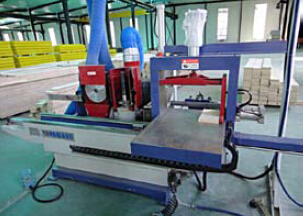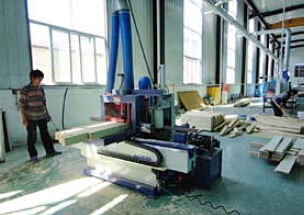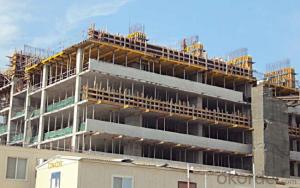Timber-Beam Formwork H20 for formwork and scaffolding systems
- Loading Port:
- Tianjin
- Payment Terms:
- TT OR LC
- Min Order Qty:
- 50 m²
- Supply Capability:
- 1000 m²/month
OKorder Service Pledge
Quality Product, Order Online Tracking, Timely Delivery
OKorder Financial Service
Credit Rating, Credit Services, Credit Purchasing
You Might Also Like
Characteristics:
◆ Standardized production lines.
Supply capability: 3000m/day, Lmax = 6600mm.
◆ Finger jointing of the flange and web, the strength of timber beam is highly improved.
Max. shearing force failure load:40KN
◆ Well treated to prevent from water penetration or erosion, so the service life maximally
extended.
Normally, CNBM timber beam H20 can be used for 4 to 5 years, the exact using time would
depend on maintenance & storage.
◆ Robust caps at the end of the girders protect against damages.




- Q:What are the different locking mechanisms used in steel formwork?
- Some of the different locking mechanisms used in steel formwork include wedge clamps, hook and wedge systems, pin and wedge systems, and snap tie systems. These locking mechanisms are designed to securely hold the formwork panels together to ensure stability and to prevent any movement or shifting during the concrete pouring process.
- Q:What are the typical lead times for manufacturing steel formwork?
- The typical lead times for manufacturing steel formwork can vary depending on factors such as the complexity of the design, the quantity required, and the current workload of the manufacturer. However, on average, lead times for manufacturing steel formwork can range from a few weeks to a few months.
- Q:How does steel formwork affect the overall acoustic properties of the structure?
- Steel formwork does not have a significant impact on the overall acoustic properties of a structure. However, it may slightly reduce sound transmission due to its dense and rigid nature compared to other formwork materials such as wood or plastic.
- Q:How does steel formwork prevent concrete honeycombing?
- Steel formwork prevents concrete honeycombing by providing a sturdy and rigid structure that holds the concrete in place during pouring and curing. This prevents the formation of voids or gaps in the concrete, ensuring a solid and uniform surface without any honeycombing.
- Q:What is the standard thickness of steel formwork
- Generally, the height of the column template is set at 1.52 or 0 5m in order to be easy to use.
- Q:Are there any specific design considerations for steel formwork systems?
- Steel formwork systems have several specific design considerations to take into account. To begin with, the load-bearing capacity of the structure should be considered. It is important to design steel formwork systems that can withstand the weight of the concrete and any additional loads, such as workers or construction equipment. The design should ensure that the steel formwork remains strong and does not deform or fail under these loads. Additionally, the dimensional accuracy and stability requirements of the concrete structure should be taken into consideration. Precision and accuracy are necessary in the design of steel formwork systems to ensure that the final concrete structure meets the desired specifications. The formwork should be rigid and stable, preventing any movement or shifting during the pouring and curing process. Furthermore, the ease of assembly, disassembly, and reusability of the steel formwork systems should be considered. These systems are often assembled and disassembled multiple times during a construction project. Therefore, the design should allow for easy and efficient installation and removal, minimizing downtime and labor costs. Additionally, the steel formwork should be durable and reusable, reducing the need for frequent replacement and contributing to cost savings. Lastly, safety aspects should be incorporated into the design of steel formwork systems. The formwork should provide a safe working environment for construction workers. This includes features such as non-slip surfaces, guardrails, and safety barriers to prevent falls or accidents. The design should also include proper access and egress points, ensuring easy movement for workers within the formwork system. In conclusion, specific design considerations for steel formwork systems include load-bearing capacity, dimensional accuracy, ease of assembly and reusability, and safety features. By taking these factors into account, designers can ensure the successful and efficient construction of concrete structures using steel formwork systems.
- Q:What are the common design considerations for steel formwork in seismic areas?
- When designing steel formwork for seismic areas, there are several common considerations that need to be taken into account to ensure the safety and stability of the structure. These considerations include: 1. Material strength: The steel used for formwork should have high tensile strength and ductility to withstand the seismic forces. High-strength steel, such as Grade 60 or Grade 80, is often used to ensure the formwork can resist the lateral forces generated during an earthquake. 2. Connection details: The connections between different steel formwork components need to be carefully designed to withstand seismic loads. Proper welding or bolting techniques should be employed to ensure the connections are strong enough to resist the dynamic forces. 3. Reinforcement: Additional reinforcement, such as steel bars or mesh, may be required in the formwork design to enhance its structural integrity. This reinforcement helps to distribute the seismic forces and prevent the formation of weak points or failure zones. 4. Stiffness and rigidity: The formwork system should be designed to be sufficiently stiff and rigid to minimize deformations and prevent excessive movement during an earthquake. This can be achieved by using thicker steel plates or adding diagonal bracing elements to increase the overall stiffness of the system. 5. Anchorage and support: The formwork needs to be securely anchored to the ground or the supporting structure to prevent it from shifting or collapsing during seismic events. Adequate anchorage and support systems, such as anchor bolts or braces, should be incorporated into the design to ensure the stability of the formwork. 6. Compatibility with other building components: The design of the steel formwork should consider its compatibility with other structural elements, such as concrete walls or columns. Proper coordination and integration with other building components are essential to ensure the overall stability and seismic performance of the structure. 7. Robustness and redundancy: The formwork design should have redundancy and robustness features to withstand unexpected loading conditions or localized damage during an earthquake. This can be achieved by incorporating multiple load paths or redundant structural elements into the formwork system. Overall, the common design considerations for steel formwork in seismic areas revolve around ensuring the strength, stability, and compatibility of the formwork system to withstand the dynamic forces generated by earthquakes. By addressing these considerations, engineers can develop robust and resilient formwork designs that contribute to the overall seismic safety of the structure.
- Q:What are the cost implications of using steel formwork?
- The cost implications of using steel formwork can vary depending on several factors. Initially, the upfront cost of steel formwork may be higher compared to other alternatives like timber or plastic. However, steel formwork offers higher durability and longevity, reducing the need for frequent replacements or repairs. This can result in long-term cost savings as steel formwork is more resistant to wear and tear. Additionally, steel formwork allows for faster construction cycles due to its sturdiness and ease of use, potentially reducing labor costs. Overall, while the initial investment may be higher, the long-term benefits and reduced maintenance expenses make steel formwork a cost-effective choice in many construction projects.
- Q:How does steel formwork handle different concrete testing procedures?
- The construction industry favors steel formwork because of its durability and versatility. When it comes to concrete testing, steel formwork proves highly capable and efficient. To begin with, steel formwork can withstand the pressure and weight exerted by concrete during various testing procedures. Regardless of whether it's a compression test, slump test, or any other form of concrete testing, the robustness of steel formwork guarantees it remains intact and does not deform under the load. In addition, steel formwork provides a smooth and even surface for concrete testing. This is crucial for obtaining accurate test results since any irregularities or inconsistencies in the formwork can impact the quality and integrity of the concrete sample being tested. Steel formwork is renowned for its precision, ensuring the concrete is poured and shaped precisely as required for each specific testing procedure. Furthermore, steel formwork is adaptable and easily modified to accommodate different concrete testing procedures. It can be adjusted or reconfigured to meet the specific requirements of various tests, such as creating different shapes, sizes, or depths for concrete samples. This flexibility allows for efficient and accurate testing, as the formwork can be customized according to the testing procedure being carried out. Moreover, steel formwork is reusable, providing cost-effectiveness and sustainability in concrete testing. Unlike other types of formwork that may need to be discarded after a single use, steel formwork can be dismantled, cleaned, and reused multiple times. This reduces overall expenses associated with concrete testing procedures and minimizes waste generation, making it an environmentally friendly option. In conclusion, steel formwork is well-suited for handling different concrete testing procedures due to its strength, precision, adaptability, and reusability. It offers a stable and consistent surface for accurate testing, ensuring reliable results. With its numerous advantages, steel formwork remains the preferred choice in the construction industry for various concrete testing requirements.
- Q:Can steel formwork be used for school construction projects?
- Indeed, school construction projects can make use of steel formwork. Steel formwork, being a resilient and versatile construction material, is capable of withstanding the immense loads and pressures encountered within school buildings. It provides a robust and steadfast framework for pouring concrete, thus ensuring the structural integrity of the construction. Furthermore, steel formwork is designed to be reusable, thereby offering a cost-effective option for school construction projects. Its adaptability allows for the creation of various shapes and sizes, catering to the distinct architectural designs typically found in school buildings. Moreover, steel formwork facilitates faster construction times when compared to traditional timber formwork, enabling the swift completion of school projects. In summary, steel formwork represents a fitting and dependable choice for school construction projects.
1. Manufacturer Overview |
|
|---|---|
| Location | |
| Year Established | |
| Annual Output Value | |
| Main Markets | |
| Company Certifications | |
2. Manufacturer Certificates |
|
|---|---|
| a) Certification Name | |
| Range | |
| Reference | |
| Validity Period | |
3. Manufacturer Capability |
|
|---|---|
| a)Trade Capacity | |
| Nearest Port | |
| Export Percentage | |
| No.of Employees in Trade Department | |
| Language Spoken: | |
| b)Factory Information | |
| Factory Size: | |
| No. of Production Lines | |
| Contract Manufacturing | |
| Product Price Range | |
Send your message to us
Timber-Beam Formwork H20 for formwork and scaffolding systems
- Loading Port:
- Tianjin
- Payment Terms:
- TT OR LC
- Min Order Qty:
- 50 m²
- Supply Capability:
- 1000 m²/month
OKorder Service Pledge
Quality Product, Order Online Tracking, Timely Delivery
OKorder Financial Service
Credit Rating, Credit Services, Credit Purchasing
Similar products
New products
Hot products
Related keywords
























